Chapter Two: The Story of
Ralph and Mary Carey
Ralph farmed with both his and Mary's fathers for awhile after they
were married. This was beneficial because the families were close neighbors
and could all be together. But after the first sons were born to Ralph
and Mary, Leonard Leon, in 1911 and Frank Edgar, in 1913, Ralph began
to long for a home on land he could call his own. He heard about land
in Wyoming offered 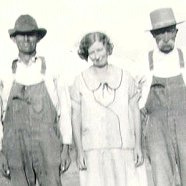 as
homesteads, and left in 1913 with friends to see for himself. as
homesteads, and left in 1913 with friends to see for himself.
He read the laws as to what was required. He must build a dwelling
place, break land, and sow forty acres, and also live on the land. Three
years were allowed to accomplish this. Ralph chose an area of three-hundred-and-twenty
acres, fifteen miles South East of Wheatland, Wyoming, in an area known
as the Hudson Valley.
Mary, Leonard and Frank soon came to Wyoming too. Of course Ralph had
not had time to build a house, but had made arrangements to live with
a cousin who was homesteading six mile to the North. They traveled to
Wheatland by train. Mary's first impressions were, "How lonely!
and this terrible wind that seems to blow continually!" Only five
houses could be seen on the way from Wheatland to the homestead site.
As it turned out, living with the cousins didn't work out very well,
so after staying for a short time, Mary and the boys returned to Oklahoma.
In a few months Ralph sent for his family again. He met them at the
depot with a team and lumber wagon. After a long, tiresome train ride,
they still had a slow, bumpy fifteen miles to cover.
Ralph had been busy while Mary was away. He had built a twelve by fourteen
foot sod house. Most of it was underground, with about three feet of
wall above. The "soddy" had three windows, one each in the
East and West sides and one in the door facing the South. The walls
were plastered inside and the floor was of wide boards. It was a warm,
cozy home.
Before Mary arrived, Ralph had bought a cook stove from a neighbor.
The door hinges were broken, but it worked fine so long as they could
keep the door propped with a stick of wood. Ralph also made a table
with two benches and cupboards for the dishes and food supplies. They
had one double bed and a trundle bed for the boys. Mary used the trunk
for their clothes and linens, since they had no closets. Later on, a
friend from Oklahoma, who was also moving to Wyoming, offered to help
them. He had engaged an "immigrant car" for shipping his belongings
and made room for Mary's sewing machine, a team of horses, and a plow.
By now Ralph was seeing the fulfillment of his dream: Land of his own,
his own home and Mary and boys with him. Mary would look out over those
vast reaches of loneliness and say, "Ralph, what do you see in
all this?" and "Why do you want to live in such a place?"
But he saw more than the windswept acres of buffalo grass. He saw a
future--and independence.
Mary would stay until she felt she couldn't stand it another day. Then
with the help of their parents, Ralph would purchase a train ticket,
help her pack, and she and the boys would go "home" for a
visit. Ralph's mother would say, "Just stay here Mary. When he
sees you aren't coming back, he'll give up that dream of his and come
back too."
But Ralph just couldn't leave the homestead, and eventually Mary would
return to try again. After a third trip and more children arrived, it
become too difficult to travel. Mary found it easier to just stay and
cope the best she could.
Helen Elizabeth was born on January 1, 1915. A neighbor lady who lived
about two miles away assisted in the delivery. How proud they were of
their first daughter. She had dark hair and dark brown eyes, "Like
Grandma Culbertson."
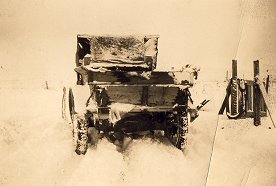 When
Helen was twelve days old, a terrible wind storm came roaring through
the area. Mary had just picked Helen up to hold her when the wind lifted
the roof, letting fall a huge pile of dirt on the bed before it settled
back down again. Mary's father was visiting at the time and helped Ralph
with temporary repairs. They carried rocks in a wash tub and piled them
on the roof. It took seven tubs full before they felt it was secure. When
Helen was twelve days old, a terrible wind storm came roaring through
the area. Mary had just picked Helen up to hold her when the wind lifted
the roof, letting fall a huge pile of dirt on the bed before it settled
back down again. Mary's father was visiting at the time and helped Ralph
with temporary repairs. They carried rocks in a wash tub and piled them
on the roof. It took seven tubs full before they felt it was secure.
Poisonous snakes were a real worry! One summer evening the boys were
playing, crawling on hands and knees around the house, down the slanting
doorway and out and around again. Later Mary found a dead snake by the
path the boys had used for their game. They never knew what or who could
have killed it. We can surely say that God watched over them on that
homestead, so far from medical help. Although snakes were plentiful
and Mary was so very afraid of them, not one member of the family was
ever bitten.
Ralph broke the land with horses and a walking plow. He planted beans
and corn with a hand planter. After the crops were in, Ralph took jobs
with other farmers on irrigated land close to Wheatland. This was necessary,
and the only way to get enough money together to live another year.
This way, too, he could be home with the family during the winter.
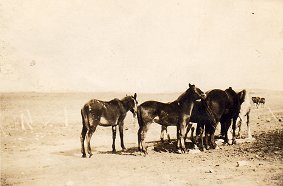 He
went to and from work on horseback, and would return home each Saturday
evening with groceries in a gunny sack tied to the saddle. There provisions
had to last the week, until he could come home again. On Sunday, Ralph
would haul a barrel of water from the neighbors. He used a team and
a home-made sled-like device he had made. This barrel of water had to
last a week--for cooking, cleaning, drinking, washing and bathing. Sometimes
the neighbors charged five cents for the water. He
went to and from work on horseback, and would return home each Saturday
evening with groceries in a gunny sack tied to the saddle. There provisions
had to last the week, until he could come home again. On Sunday, Ralph
would haul a barrel of water from the neighbors. He used a team and
a home-made sled-like device he had made. This barrel of water had to
last a week--for cooking, cleaning, drinking, washing and bathing. Sometimes
the neighbors charged five cents for the water.
Ralph would leave on Sunday afternoon to ride the fifteen miles back
to Wheatland, to be ready for work the next day. Then another lonely
week would begin for Mary. How afraid she was! How long it seemed until
the next Saturday night, when Ralph came home again. He worried about
leaving them and was anxious until Saturday came so he could go home
for a few hours to see if all was well.
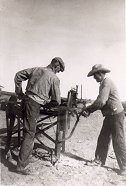 At
this time, Wyoming had no range laws and there were no fences. People
who raised cattle allowed them to roam free and feed on the grass, checking
them occasionally to see that they did not stray too far. One neighbor
was especially careless about taking care of his cattle, and Mary had
to run and drive them out of the grain that had been gathered and stored.
At times, they even attempted to drink from the barrel of precious water! At
this time, Wyoming had no range laws and there were no fences. People
who raised cattle allowed them to roam free and feed on the grass, checking
them occasionally to see that they did not stray too far. One neighbor
was especially careless about taking care of his cattle, and Mary had
to run and drive them out of the grain that had been gathered and stored.
At times, they even attempted to drink from the barrel of precious water!
One day, Ralph brought home a little black dog named Jack. He was sure
Jack could be trained to chase the cows and so relieve Mary of this
chore. How excited the boys were when they saw the cows headed for the
corn pile! Jack would chase them, bite their legs and save the day!
But much to their disappointment, Jack was afraid of the cows and refused
to leave the house while they were near. This day Mary felt desperate
and so angry at the cows and the helplessness she felt about it all
that she loaded up the shot-gun ran out, aimed into the herd, and fired.
BOOM! What a kick the gun had! Mary, somewhat subdued, picked herself
up, rubbing her shoulder which would carry a bruise for several days.
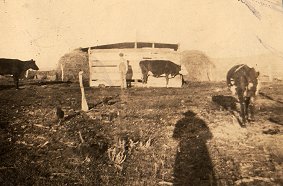 Jack
did give them one exciting day. A neighbor came to visit, driving a
Model T Ford. When he tried to crank the car to leave, 'ol Jack came
leaping out and grabbed the seat of his pants. So the man would cease
cranking until Jack calmed down. When he attempted to crank again, Jack
would grab hold again. The boys finally held the dog until the neighbor
could get away. Jack
did give them one exciting day. A neighbor came to visit, driving a
Model T Ford. When he tried to crank the car to leave, 'ol Jack came
leaping out and grabbed the seat of his pants. So the man would cease
cranking until Jack calmed down. When he attempted to crank again, Jack
would grab hold again. The boys finally held the dog until the neighbor
could get away.
In the Winter of 1916 many of the people in Hudson Valley were very
ill with a flu. Mary and Ralph were too, and finally reached the point
of weakness or perhaps a state of delirium, that they could no longer
keep the fire going. They awoke to the noise of someone in the house.
A neighbor (a distant relative) had stopped by to see them. He was building
the fire. The Careys were thankful for a good friend who cared--and
came just in time.
For a short time in 1917, Ralph worked for a farmer near Wheatland who
furnished houses for his hired help. Mary and the children were able
to move there, so they could be together. During this time Nellie May
was born. They were able to pay for and obtain a doctor to come to the
house this time.
In 1918, Ralph built a two-room frame house about a half-mile to the
North of the homestead. It was much nicer and roomier. Relatives were
always welcome at the Careys'. Ralph's parents came to visit several
times. Even in the small house they were made to feel welcome. Mr. Goebel
came to spend several winters. He always brought his fiddle and made
the evenings lively with his music. Mary especially liked this. She
used to say, "I was raised on fiddle music." Hazel Inez was
born in 1919, in this home in Hudson Valley.
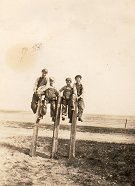 The
Careys were anxious to have a school near enough for the children to
walk to. Leonard, at age eight, had attended a school two-and-a-half
miles away. It was such a worry to see him have to walk so far. With
so many other complications his attendance was erratic. Finally it was
decided to build a school on the school section three quarter of a mile
to the South of the Carey place. Ralph, with a team and wagon, hauled
the cement, lumber and other materials needed to build the school. They
piled the sacks of cement in the kitchen where it would keep dry until
needed--but the weight broke the floor! The school was finally built
and named "Carey School" in appreciation of the efforts of
Ralph and Mary. The five oldest were graduated from the eighth grade
there. Later, as many little country schools were consolidated, the
Carey School also was no longer needed. Even though the echoes of its
last students faded long ago, the building itself can still be seen
today, used now as a bunk house on the Hal Ashenhurst place, about five
miles from its original location. The
Careys were anxious to have a school near enough for the children to
walk to. Leonard, at age eight, had attended a school two-and-a-half
miles away. It was such a worry to see him have to walk so far. With
so many other complications his attendance was erratic. Finally it was
decided to build a school on the school section three quarter of a mile
to the South of the Carey place. Ralph, with a team and wagon, hauled
the cement, lumber and other materials needed to build the school. They
piled the sacks of cement in the kitchen where it would keep dry until
needed--but the weight broke the floor! The school was finally built
and named "Carey School" in appreciation of the efforts of
Ralph and Mary. The five oldest were graduated from the eighth grade
there. Later, as many little country schools were consolidated, the
Carey School also was no longer needed. Even though the echoes of its
last students faded long ago, the building itself can still be seen
today, used now as a bunk house on the Hal Ashenhurst place, about five
miles from its original location.
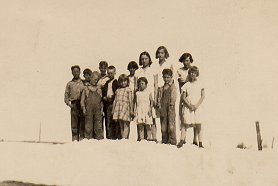 In
1923, the four in school came home with an exciting tale about a teacher
not feeling well. She had told them she was afraid she had the measles.
This was disturbing news for Mary, because she was pregnant and had
not yet had the measles herself. It was expected that Leonard, Frank,
Helen and Nellie would all get the measles after being exposed by the
teacher. Mary was very much concerned about the welfare of the baby. In
1923, the four in school came home with an exciting tale about a teacher
not feeling well. She had told them she was afraid she had the measles.
This was disturbing news for Mary, because she was pregnant and had
not yet had the measles herself. It was expected that Leonard, Frank,
Helen and Nellie would all get the measles after being exposed by the
teacher. Mary was very much concerned about the welfare of the baby.
It was decided that just before the incubation period for measles was
ending and the older children would be getting them, Mary and Hazel
would go to live in a house about a mile away. The owners were not living
there at the time and gave their consent. Ralph would have to nurse
the older children through the illness alone. This plan was never carried
out, as the doctor decided it was unnecessary. He believed that Mary
was far enough along in her pregnancy to be safe.
The four children had the measles and Ralph and Mary nursed them through
the illness together. Then, as Mary had feared, she and Hazel got them
too. Early in her sickness, Mary knew all was not well with the baby,
and eventually miscarried.
Mary could remember seeing two little feet and asked the doctor about
the baby. He said, "It was a boy." Mary asked to see the baby,
but the doctor replied, "No, Mrs. Carey, you don't want to see
this baby." She remembered the doctor giving a bundle to Ralph,
and afterwards realized he had had to bury the baby. He refused to talk
about it or tell where he made the little grave. Mary always like the
name of Carlas. Perhaps the baby would have been given that name.
The Carey family were all avid readers who made good use of the library
when it was opened in Wheatland. They each had a library card as soon
as they were eligible. When Ralph went to town he would stop by the
library and get as many books as the rules would allow. Mary liked Zane
Grey's Western stories and read every one the library carried. It was
always an exiting time when Dad cam home with the new books. The family
spent many a pleasant evening around the big heating stove with a pan
of popcorn and a good book. They could read and dream of far away places.
Sometimes a neighbor would give a house party. Each family would take
a cake, home-made ice-cream or sandwiches. The "old folks"
usually played "Pitch" and the young ones played "Skip
to my Lou" or similar games. Barn dances were popular too. Ralph
and Mary loved to square dance and Ralph was asked to call them quite
often. There were welcome breaks in the routine of farm work and raising
children. Usually the family went together, but sometimes Ralph would
buy a sack of peanuts in the shell and the children would stay home
and have a real treat!
Ralph raised beans and found he could get better price if he could
say they were and-picked. So after supper he would pour a pile of beans
in the center of the kitchen table. The family gathered around and separated
the good beans from the cracked ones; the rocks and other debris. This
really wasn't hard. They made a fun time of it and ti became on of those
"good memories".
They raised a large garden. Mary would can everything she possibly
could in preparation for the winter ahead. It was years before she had
a pressure canner, and so used the boiling water method. The food was
put into jars, then onto a rack in the wash boiler. They had to boil
many hours on the cook stove, using wood and a fire. This was a hard,
hot, grueling job, but necessary for their welfare. Mary would can as
much as 500 quarts in a season. These were put into a cellar along with
potatoes, squash and other staples.
In those days, visits from the neighbors were few and far between.
It was hard to find time or a way to travel. Mary never went to Wheatland
for a period of seven years. With the small children, chores to do and
a thirty-mile round-trip by wagon, it was just easier to stay home.
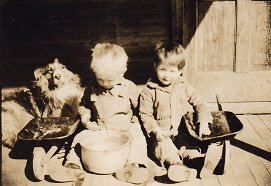 On
December 3, 1925, the Wheatland Times published this report: On
December 3, 1925, the Wheatland Times published this report:
" Event of Historical Import Eventuates Sunday in Hudson Valley…While
the first white child born in Wheatland may be a matter for future historians
to battle over, and the first born in Hudson Valley may also be a matter
for debate and research by recorder of times to come, there is one historical
fact that Times wishes to put on record while it is still fresh-and
that is that the first twins born in the Hudson Valley and Eagle's Nest
territories were born Sunday morning November 29, to Mr. and Mrs. Ralph
Carey. Both are boys and both are reported to be in first class health"
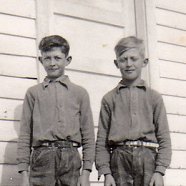 The
twins were named Lawrence Harvey and Lester Ralph. They were not strong
babies and since the November weather was bitterly cold, many anxious
hours were spend caring for them. One neighbor, considering the financial
situation of the Careys', made a special trip to visit, and before leaving
asked for one the babies! Unthinkable! The
twins were named Lawrence Harvey and Lester Ralph. They were not strong
babies and since the November weather was bitterly cold, many anxious
hours were spend caring for them. One neighbor, considering the financial
situation of the Careys', made a special trip to visit, and before leaving
asked for one the babies! Unthinkable!
Mary was quit ill for a week for some time. Helen and Nellie, ten and
eight years of age, did much of the housework. A woman was hired to
help out as well. Mom was really missed by her family, and it was a
happy day when she was up and about-and doing her good cooking again.
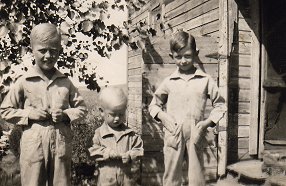 Kenneth
Dale was born in 1939. This delivery was not as traumatic for Mary,
and she recovered rapidly. Kenneth
Dale was born in 1939. This delivery was not as traumatic for Mary,
and she recovered rapidly.
In *1927, Ralph bought a house from a farmer about ten miles away.
It had four room, two upstairs. He moved it with a team of horses, dragging
it on logs across the fields. He also bought a one room house from about
three miles away. He moved the old two room house out to be used as
a grainery and put the one-room and the four-room home with an upstairs!
One room was not finished for several years, but made a handy store
room.
*(not sure of date)
One wonders how many today would expend such an effort. It seems an
impossible task to feed and clothe a family of ten, put a home together
for their comfort, and be always eager to plan and dream for another
year, another crop, more improvements, and a better environment for
those who looked to him for security.
When Leonard and Frank were about 15 years old, they were able to work
for other farmers. They too had a desire to be out on their own and
have money to spend.
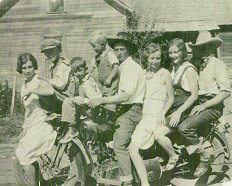 One
of the first items Leonard bought was a linoleum rug for his mother's
kitchen floor. Mary was very proud of the pretty floor and the way it
could be cleaned so easily. Both Leonard and Frank helped to buy a Maytag
washer with a gasoline motor. This was like a bit of paradise! How many
hours Mary has spent scrubbing clothes on a washboard, and then for
a time on a hand-powered washing machine. Now here washdays were almost
fun. Of course the water for washing still was carried in pails from
the well and heated on the coal stove in a broiler, but how she loved
that Maytag! One
of the first items Leonard bought was a linoleum rug for his mother's
kitchen floor. Mary was very proud of the pretty floor and the way it
could be cleaned so easily. Both Leonard and Frank helped to buy a Maytag
washer with a gasoline motor. This was like a bit of paradise! How many
hours Mary has spent scrubbing clothes on a washboard, and then for
a time on a hand-powered washing machine. Now here washdays were almost
fun. Of course the water for washing still was carried in pails from
the well and heated on the coal stove in a broiler, but how she loved
that Maytag!
During the time the Careys lived on the farm, the area became quite
well populated. Farm homes were on nearly every section of land. Before
Mary left the farm in 1956, many of those neighbors had gone. People
were forced out because of crop failures brought on by hail, wind and
drought. Some gave up the struggles against the elements and mortgage
payments, and moved on again to try some other place. In 1947 Mary's
father passed away, leaving her a small inheritance. This was used to
purchase an additional three-hundred and twenty acres of land from a
neighbor who was giving up and moving on.

|